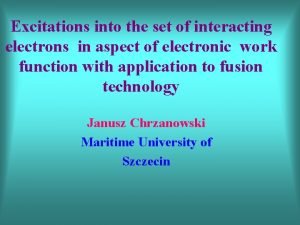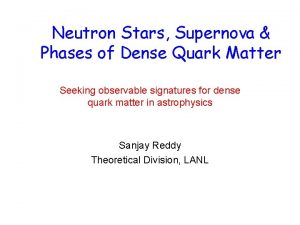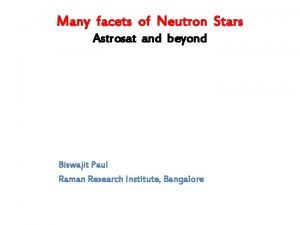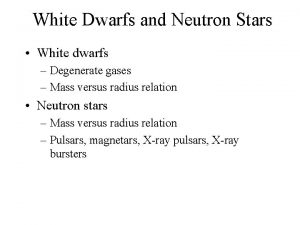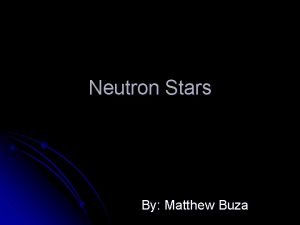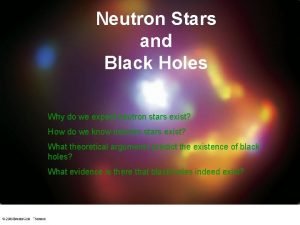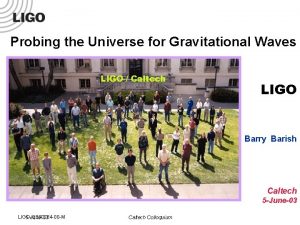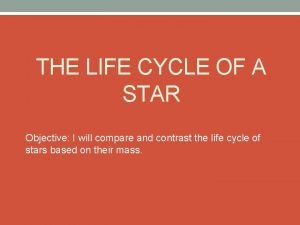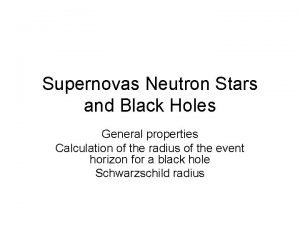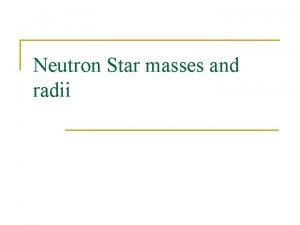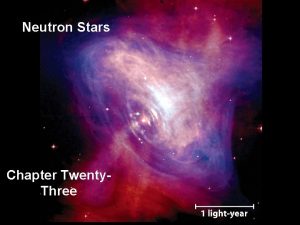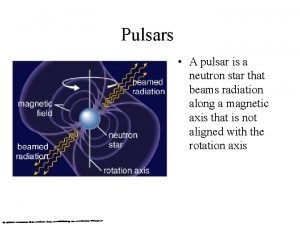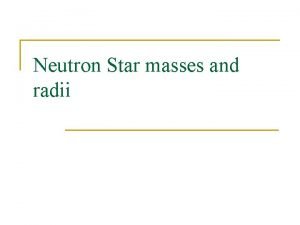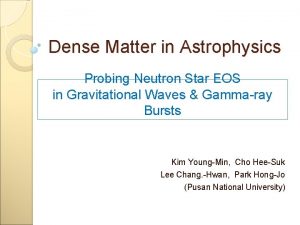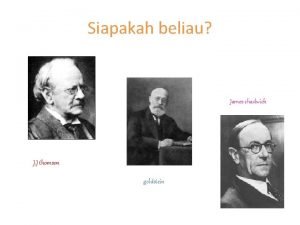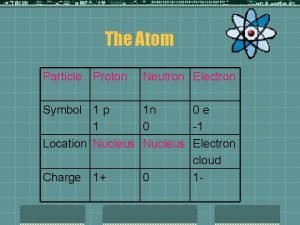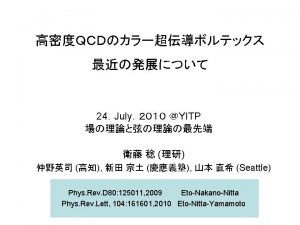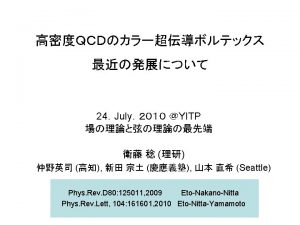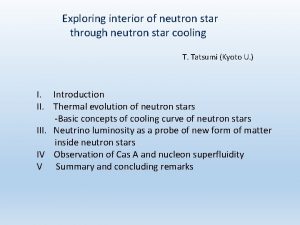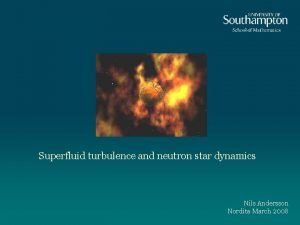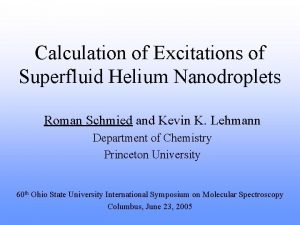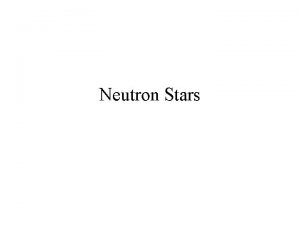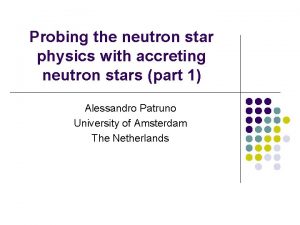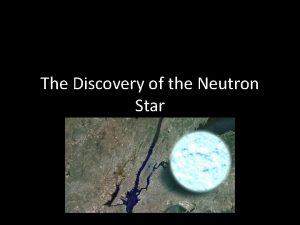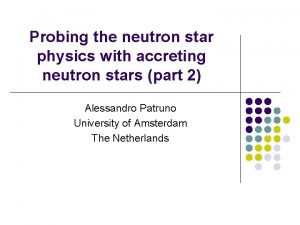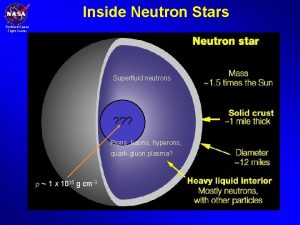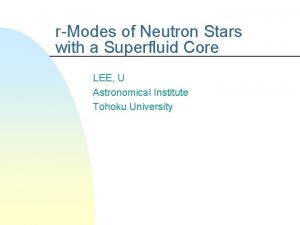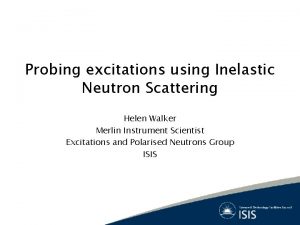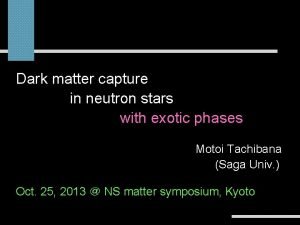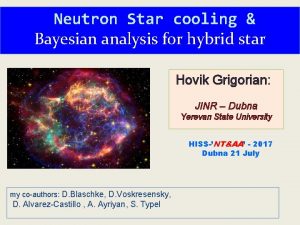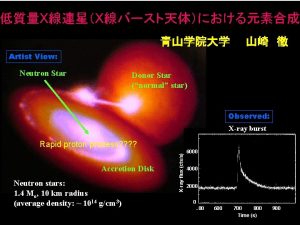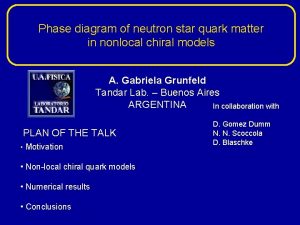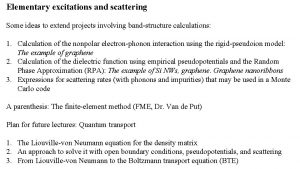Elementary excitations in superfluid Neutron Star matter M































- Slides: 31

Elementary excitations in superfluid Neutron Star matter M. Baldo INFN, Sezione di Catania Coimbra , September 2018

A section (schematic) of a neutron star

MOTIVATIONS. Neutrino emission from the superfluid matter. Neutrino mean free path. Heat capacity. Thermal and electrical conductivity. Transport coefficients (e. g. shear viscosity)

Possible physical processes Neutrino emission # A collective mode with energy linear in momentum cannot decay into a neutrino-antineutrino pair. It is essential to know the strength function # Vertex renormalization of the response function Neutrino mean free path # Scattering from the Goldstone mode or collective modes in general Heat capacity # Counting correctly the effective degrees of freedom Transport coefficients #Direct contribution of the superfluid phonons (Tolos et al. PRC 90, 055803 (2014), PRD 84, 123007 (2011))

Some references J. Kundu and S. Reddy, PRC 70, 055803 (2004) L. B. Leinson and A. Perez, PLB 638, 114 (2006) A. Sedrakian, H. Muether and P. Schuck, PRC 76, 055805 (2007) A. W. Steiner and S. Reddy, PRC 79, 015802 (2009) L. B. Leinson, PRC 79, 045502 (2009) E. Kolomeitsev and D. Voskresenky, PRC 81, 065801 (2010) M. B. and C. Ducoin, PRC 84, 035806 (2011); PRC 96, 025811 (2017) N. Martin and M. Urban, PRC 90, 065805 (2014)

We will include neutron, proton and electron components Some questions to be answered. How much protons and neutrons decouple ? . How efficient is the electron screening ? . How much neutron modes are affected by protons ? . Are the phonon damped ? How much ?

Basic equation for the strength functions

Linear response including electrons and protons only

NORMAL SYSTEM. Electron screening effect. From the proton plasmon to the sound mode Static electron background Plasmon mode With screening Sound mode

Proton and electron spectral functions. Normal system M. B. and C. Ducoin , PRC 79, 035901 (2009)

Overview of superfluid gaps in homogeneous matter Since the gaps are largely unknown, they will be treated as parameters

Pairing interaction only Spectrum Strength function Goldstone mode Pair-breaking mode

Including the Coulomb interaction Death and resurrection of the Goldstone mode Static electrons Proton plasmons Including electrons “Pseudo-Goldstone” mode

Evolution of the spectrum. Pairing + Coulomb


From the pseudo-Goldstone to the sound mode Pseudo. Goldstone Sound mode

The electron plasmon damping

Including the nuclear interaction and neutrons in the normal phase Nuclear interaction from BHF as Skyrme-like functional monopolar approximation

A comparison No np coupling With np coupling Notice : no sound mode for the neutron gas ( attractive nn particle-hole effective interaction )

Two times saturation density

Both proton and neutron superfluid (work in progress) Proton gap = 1 Mev, neutron gap = 1. 5 Me. V Saturation density. No pn interaction

Introducing proton-neutron coupling Proton gap = 1 Mev, neutron gap = 1. 5 Me. V Saturation density

Introducing proton-neutron coupling Neutron-proton pair vibrations Neutron-electron coupling

Smaller neutron gap No p-n interaction With p-n interaction Proton gap = 1. 0 Mev, neutron gap = 0. 5 Me. V Saturation density

Higher momentum No p-n interaction With p-n interaction Proton gap = 1. 0 Mev, neutron gap = 0. 5 Me. V Saturation density

At twice saturation density Neutron pseudo-Goldstone Neutron sound mode

At twice saturation density No neutron superfluidity. Sharp neutron sound mode

CONCLUSIONS. The electron screening suppresses the proton plasmon mode which is converted into a sound mode above 2. The proton component has relevan effect on the spectral functions. . At increasing value of the superfluid proton gap the electron plasmon is rapidily suppressed. . Each superfluid component is characterized by a pseudo. Goldstone mode below 2 and a pair-breaking mode above 2 , which merges into a sound mode at increasing momentum.

. The possible proton pseudo-Goldstone mode is damped by the coulomb coupling with the electrons. . If one includes the neutron-proton interaction the pseudo-Goldstone mode becomes a neutron-proton mode and it is damped. . The overall spectral function is distorted by the neutron-proton interaction. . If the neutrons are in the normal phase, the sound mode can undergo Landau damping, depending on the interaction at the different densities

OUTLOOK. Extend the analysis to the 3 P 2 superfluidity. (Bedaque et al. Phys. Rev. C 92, 035809 (2015)). Extend the analysis to the vector channel. . Relevance of the phonons on different phenomena, e. g. cooling. . Relevance of the phonon damping on the different physical processes. . Lepton-lepton collisions mediated by proton phonons. (Shternin, PRD 98, 063015 (2018)). Establish the scenario of Neutron Star matter superfludity (where proton and neutron superfluidity are present ? )

Position of the centroid of the peak in the proton spectral function
 Superfluid example
Superfluid example Excitations
Excitations Myrrh is mine its bitter perfume
Myrrh is mine its bitter perfume Neutron star
Neutron star Neutron star
Neutron star Neutron degeneracy pressure
Neutron degeneracy pressure Neutron star
Neutron star Anatomy of a star
Anatomy of a star Binary neutron star
Binary neutron star Star objective
Star objective Gravitational radius
Gravitational radius Neutron star
Neutron star Neutron star
Neutron star Neutron star router
Neutron star router Tychos snr
Tychos snr Neutron star
Neutron star Neutron star
Neutron star A* and ao* algorithm
A* and ao* algorithm What does star in star events stand for?
What does star in star events stand for? Classification of matter section 1 composition of matter
Classification of matter section 1 composition of matter Gray matter and white matter
Gray matter and white matter Chapter 2 section 1 classifying matter answer key
Chapter 2 section 1 classifying matter answer key What is gray matter in the brain
What is gray matter in the brain Classification of matter section 1 composition of matter
Classification of matter section 1 composition of matter Label the cranial dura septa and associated sinuses.
Label the cranial dura septa and associated sinuses. Energy naturally flows from warmer matter to cooler matter.
Energy naturally flows from warmer matter to cooler matter. Function of grey matter and white matter
Function of grey matter and white matter Section 1 composition of matter
Section 1 composition of matter Photon neutron
Photon neutron Masa del neutron
Masa del neutron Siapakah penemu elektron
Siapakah penemu elektron Symbole proton neutron electron
Symbole proton neutron electron

